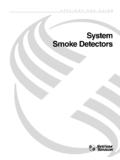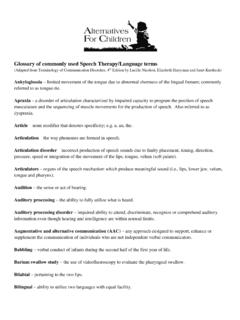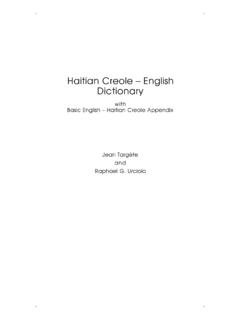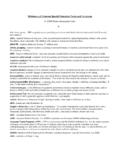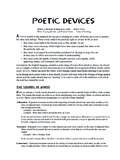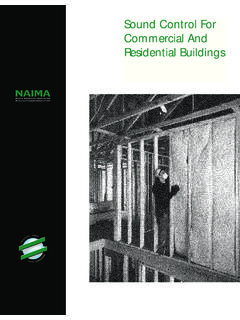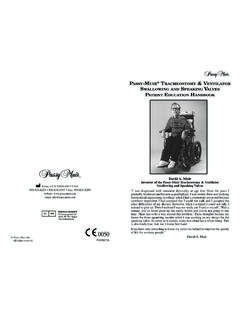Transcription of Voice Evacuation Systems - Smoke Detection, CO Detection ...
1 A P P L I C A T I O N S G U I D E. Voice Evacuation Systems A P P L I C AT I O N S G U I D E : V O I C E E VA C U AT I O N S Y S T E M S. Voice Evacuation Systems Contents Section 1: Factors that are controllable by a Voice Evacuation system What is the driving factor for Voice Evacuation Systems ?..3 Signal-to-noise Section 2: Basics of Speaker Frequency Response ..7. What is sound?..3 Total harmonic How does sound travel?..3 Speaker Section 3: Measuring Sound Voltage drop on speaker Sound Pressure Level (SPL)..3 Factors that are not controllable by a system Room A-Weighted Countering the effects of B-Weighted Section 8: Testing for C-Weighted Measurement Adding SPL from two Intelligibility Measurement dB Rules of Quantitive Method Tips and Section 4: Basics of Speaker Testing Methods: When and Cone Use of Intelligibility High Impedance ( Volt/25 Volt) Distributed Line Direct injection method for test Section 5: Basics of Voice Evacuation system Calibrating Signal Section 6: Laws, Codes and Standards Method Relevant to Voice Evacuation Method Accessibility STI/STIPA Test Anechoic vs.
2 Reverberant Occupied International Building Code & International Fire Unoccupied NFPA 72 , The National Fire Alarm and Signaling Acceptable Audibility Requirements Per NFPA 72:2010 or 2013 Limitations of Test ANSI/UL 1480 and Section 9: Glossary of 11. Section 7: Designing for Section 10: Section 11: Additional 12. How to Layout Voice 2. S Y S T E M S E N S O R. Section 1: Section 2: Introduction Basics of Sound The purpose of this guide is to provide information about Voice alarm sys- What is sound? tems used in conjunction with fire alarm and emergency communication Systems . Voice communications are extensively used to provide build- Sound is created by mechanical vibrations that displace air molecules to ing occupant notification during emergencies. These messages contain create repetitive changes in air pressure. The ear detects these changes in vital safety information that must be clearly understood by the building air pressure and perceives the magnitude as loudness and the frequency occupants.
3 As pitch. While the information in this guide is based on years of industry experience, The standard ear can hear from a wide range of 20 Hz through 20,000 Hz. it is intended to be used only as a guide. The requirements of applicable Table 1. codes and standards, as well as directives of the authority having juris- diction (AHJ) should be followed. In particular, the most current version of NFPA 72 , National Fire Alarm and Signaling Code , now requires that Young children up to 25 Khz emergency Voice /alarm communications Systems be intelligible and dis- cusses methods for verifying intelligibility. 13 years and up up to 20 KHz This guide provides general information on the concepts of intelligibility Adults up to 16 KHz and the design of emergency Voice /alarm communications Systems . It is intended to provide a better understanding of the factors affecting the intel- Elderly adults depends on lifetime noise exposure ligibility of these Systems in public spaces, in order to improve design of Systems that meet the requirements for speech audibility and intelligibility Speech frequencies range from 500Hz to 4,000 Hz in a cost-effective manner.
4 How does sound travel? What is the driving factor for Voice Evacuation Systems ? The air molecules themselves don't move very far. They simply transfer pres- sure changes into sound waves. Sound waves move away from the sound Intelligibility for mass notification Systems had its inception with the source, such as a speaker, at a speed determined by the sound source. Department of Defense Unified Facilities Criteria (UFC) document 4-021- The more power the source emits, the wider the sound waves spread. In 01, the Design and O&M: Mass Notification Systems . addition, the further out the sound waves travel from the source, the less intense they become. Voice Evacuation Systems are growing in popularity and, required in more areas. The events of September 11, 2001, were a main driver because they Sound waves are regularly intercepted by other sound waves. Imagine highlighted the need to communicate to a large group of individuals out- two children jumping into the water at the same time: their waves overlap.
5 Side of a fire event. That is especially critical for buildings where you have Similarly, when a sound wave is intercepted by an outside force, a portion to manage the Evacuation of complex layouts, such as high-rise buildings is reflected into a different direction. As a result, before installing a Voice or large areas of assembly. Evacuation system , it's imperative to understand sound output and the way sound waves reflect and interact. Prior to these emergency events, Voice Systems would only be used period- ically during fire drills. Due to the need for constant communication, design Section 3: importance and Voice message intelligibility are critical. Measuring Sound Output Although it's necessary to communicate with occupants regarding a multi- Sound Pressure Level (SPL). tude of emergencies, such as weather threats or toxic gases, a traditional Evacuation tone may not be an ideal signal for non-fire events where seek- SPL is the difference between the pressure produced by a sound wave ing shelter is preferred to Evacuation .
6 And the ambient pressure at some point in space. Sometimes SPL is con- fused with loudness of sound, but in reality SPL is a contributing factor of States are also moving to the latest editions of the National Fire Alarm loudness but not loudness itself. The SPL range for the human ear is from Signaling Code and building codes, which require Voice Systems in cer- 0 to 120 decibels. Going louder, the human threshold of pain is 130 deci- tain occupancies. bels. Eardrums rupture at 190 decibels. Basic components should be reviewed in order to understand Voice Systems . 3. A P P L I C AT I O N S G U I D E : V O I C E E VA C U AT I O N S Y S T E M S. Decibel SP1 = 80dB. Audio levels are commonly used by engineers using Decibels (dB) to express ratios between levels, such as power, Volts, Amps, and Sound SP2 = 80dB. Reference P0=1pW=10-12W. Pressure Levels (SPL). The decibel is not an absolute measure like Volts and Amps; rather, it is used to make comparisons between two numbers.
7 The decibel is defined as the logarithm of two power levels, shown below in the equation as P1 and P0: dB=10log(P/P0). P1 80=10log(P/10-12). Decibel = 10 log P0 8=log(P/10-12). P0 is the reference power (P0=1pW=10-12W) and P1 is the power level 10^8=(P/10-12). used for comparison. The logarithm is used in the decibel in order to make comparisons of power over a very wide range. This is very useful in audio P=(108)(10-12)=(10-4)=.0001W. applications as the ear responds logarithmically to changes in SPL. When the decibel is used to express SPL, the reference sound pressure 2P=2*.0001W=.0002W. is 20 x 10-6 Newtons/m which is the approximate hearing threshold for a normal listener. When using a dB meter to measure sound, the meter is per- dB=10log((.0002/10-12))=83. forming the calculation between the received SPL and the reference SPL: SPL Online tools for SPL addition can simplify this process.
8 If the two dB lev- dBspl = 20log els are identical, then simply add 3 dB to either one. If the SPL from one 20 x 10-6. speaker is more than 10 dB higher than the other, then simply use the higher SPL value. A-Weighted Scale dB Rules of Thumb An A-weighting filter is sometimes used when measuring SPL with frequen- Sound pressure levels drop approximately 6 dB for every doubling of dis- cies around 600- 7,000 Hz. Because speech frequencies range from 500 tance and increase by 3 dB for every doubling of power. For example, to 4,000 Hz, the filter ensures that the measured dB corresponds with per- take a one watt speaker that provides 85 dBA at 10 feet. At two watts, the ceived loudness. In other words, the filter desensitizes the sound level meter speaker will provide 88 dBA at 10 feet and 82 dBA at 20 feet. This rule to the extreme high and low frequencies. These sound levels are still mea- of thumb is important to remember when determining whether you need sured in decibels, but are symbolized by dBA.
9 Fewer high powered centralized speakers or more low-powered dispersed speakers. B-Weighted Scale 85 dBA. A B-weighting scale is sometimes used when measuring SPL with frequen- cies around 300- 4,000 Hz. 1W 10ft C-Weighted Scale 88 dBA. An C-weighting filter is sometimes used when measuring SPL with frequen- 2W 10ft cies around 70Hz-4,000 Hz. 82 dBA. A-weighted scale is referenced in most test and building standards but the C-weighted scale is useful for measuring the peaks of the noise levels. 2W 20ft Adding SPL from two speakers If there is an application with two speakers in close proximity, the sound Figure 1. dB Rules of Thumb from the speakers is additive. However, the dB levels cannot simply be added together to determine the sound level. Instead, the SPLs have to be converted back to their actual powers and then added them to recal- culate the level in dB. For example, one 80 dB speaker plus a second 80.
10 DB speaker doesn't equal 160 dB. 4. S Y S T E M S E N S O R. Section 4: Other standard amplifier features are field-adjustable voltage (25 or Basics of Speaker Operation volts); built-in alert tone generators with steady, 520 Hz square wave, slow whoop, high/low or chime capabilities; field-selectable tones; speaker zone Cone Materials control; independently field-programmable input circuits; power-limited outputs; auxiliary power outputs that provide local power for addressable The cone, the part of the speaker that physically moves the air molecules, control modules; and compatibility with fire alarm control panels. comes in a variety of materials, including paper, polypropylene, and carbon fiber. Newer digital Voice Systems provide the ability to create custom pre- recorded tones or messages. They can also distribute messages across Paper is the conventional material for speaker cones because it is easy multiple-channels.
